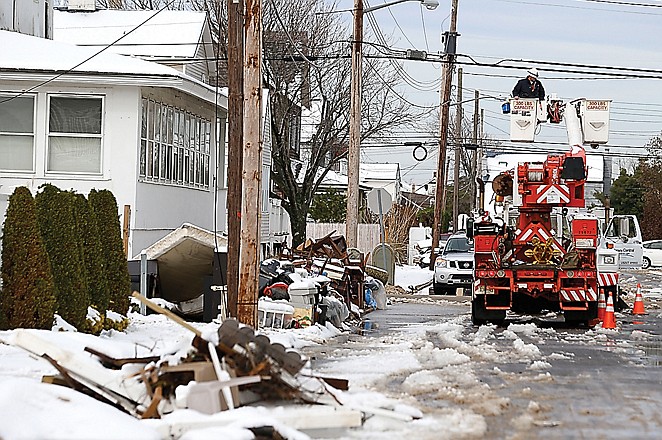FARMINGDALE, N.Y. (AP) - Vincent Pina finally saw a couple of utility trucks coming down his street Thursday and started to wave in anticipation. But they just cruised past his house and kept on going.
He hung his head in resignation.
"The thing that gets me the most is that there is no flood damage. I don't have any branches down. I have no wires down," said the Long Islander, who put a hand-painted sign out front that read: "Still No Power."
So why, he wondered, was it taking so long to get electricity?
A week and a half after Superstorm Sandy slammed the coast and inflicted tens of billions of dollars in damage, hundreds of thousands of customers in New York and New Jersey are still waiting for the electricity to come back on, and lots of cold and tired people are losing patience. Some are demanding investigations of utilities they say aren't working fast enough.
An angry New York Gov. Andrew Cuomo joined the calls for an investigation Thursday, ripping the utilities as unprepared and badly managed.
"Privately I have used language my daughters couldn't hear," he fumed. He added: "It's unacceptable the longer it goes on because the longer it goes on, people's suffering is worse."
The power companies have said they are dealing with damage unprecedented in its scope and doing the best they can. And there is no denying the magnitude of what they have done: At the peak, more than 8.5 million homes and businesses across 21 states lost power. As of Thursday, that was down to about 750,000, almost entirely in New York and New Jersey.
And that's after a nor'easter overnight knocked out power to more than 200,000 customers in New York and New Jersey, erasing some of the progress made by utility crews.
"We lost power last week, just got it back for a day or two, and now we lost it again," said John Monticello of Point Pleasant Beach, N.J. "Every day it's the same now: Turn on the gas burner for heat. Instant coffee. Use the iPad to find out what's going on in the rest of the world."
The mounting criticism came as New York City and Long Island followed New Jersey's lead and announced odd-even gasoline rationing to deal with fuel shortages and long lines at gas stations; the Federal Emergency Management Agency started bringing mobile homes into the region; and Cuomo said the storm could cost New York State alone $33 billion.
New Jersey did not have a damage estimate of its own, but others have put Sandy's overall toll at up to $50 billion, making it the second most expensive storm in U.S. history, behind Hurricane Katrina, which swamped New Orleans in 2005.
Sandy killed more than 100 people in 10 states, with most of the dead in New York and New Jersey.
The power industry's defenders have pointed out that Sandy was huge and hit the nation's most densely populated corridor. By the Energy Department's reckoning, it left more people in the dark than any other storm in U.S. history.
It did more than knock down power lines; it flooded switching stations and substations, forcing workers to take apart hundreds of intricate components, clean them, replace some of them, rewire others and put it all back together. Only after these stations are re-energized can workers go out and repair lines.
In Rockaway Beach in Queens, crews worked Thursday to inspect the flooded, muck-filled utility tunnels that carry current. Before they descended into the manholes, Ed Sellman used a 3,400-gallon vacuum truck to suck up the sand coating the subterranean cables.
"We try to get it clean, so when they go down there to do the inspections, they can see and aren't working in mud like pigs," Sellman said.
Around the region, though, customers were frustrated and in some cases furious, complaining that they were being left in the dark about when power would be restored.
New York's Democratic governor blasted the utilities as "nameless, faceless" monopolies that weren't up to the job, complaining: "They ran out of poles, believe it or not. ... How do you run out of poles?"
"The management has failed the consumers. It is just that simple," said Cuomo, whose power at his own home in the suburbs has been on and off.
In contrast, New Jersey Republican Gov. Chris Christie praised the utilities, saying he expected all of the state to have power back by early Sunday. New Jersey had about 400,000 power outages on Thursday.
"The villain in this case is Hurricane Sandy," Christie said.
On Long Island, where more than 262,000 customers were without power and tempers were rising, Long Island Power Authority spokesman Mark Gross would not comment on the criticism, saying only that the utility is focused on restoring power.
Alfonso Quiroz, a spokesman for Con Ed, the chief utility in New York City, said: "I think we're going to be able to power through. Our objective was to get power restored to everyone by the weekend, and we're still working with that goal."

